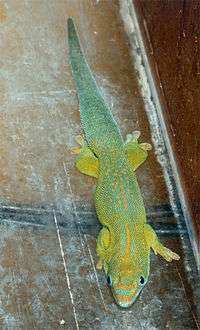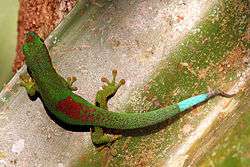Phelsuma
| Phelsuma | |
|---|---|
| | |
| Gold dust day gecko, Phelsuma laticauda | |
| Scientific classification | |
| Kingdom: | Animalia |
| Phylum: | Chordata |
| Subphylum: | Vertebrata |
| Class: | Reptilia |
| Order: | Squamata |
| Suborder: | Sauria |
| Infraorder: | Gekkota |
| Family: | Gekkonidae |
| Subfamily: | Gekkoninae |
| Genus: | Phelsuma Gray, 1825 |
| Species | |
|
43 species; see text. | |
Phelsuma is a large genus of mostly small lizards in the family Gekkonidae. Species in the genus Phelsuma are commonly referred to as day geckos.
Description

In contrast to most other gecko species, day geckos are active mainly during the day. Other diurnal geckos include species of the genera Lygodactylus and Gonatodes. As with all other geckos, day geckos lack eyelids, having, instead, rounded pupils and a clear, fixed plate covering their eyes which they clean with their tongues. Many species have bright green, red, and blue colors which make them popular terrarium or vivarium pets. These brilliant colors play a role in intraspecies recognition and also serve as camouflage.
The length of the different Phelsuma species varies between about 6.5 and 30 centimetres (2.6 and 11.8 in), but the extinct Rodrigues giant day gecko was even larger. Day geckos have toe pads consisting of tiny lamellae which allow them to walk on plain vertical and inverted surfaces like bamboo or glass. The inner toe on each foot is vestigial. Males have well-developed femoral pores on the undersurface of their rear limbs. These pores are less developed or absent in females. Females often have well-developed endolymphatic chalk sacs on the sides of their necks. These sacs store calcium, which is needed for egg production. Those eggs can often be seen through the ventral surface of the female's body shortly before they are laid. The hatchlings reach sexual maturity between six and 12 months old. Smaller species may live up to 10 years, whereas the larger species have been reported to live more than 20 years in captivity.
Distribution and habitat
Day geckos inhabit the islands of the south-west part of the Indian Ocean. The exceptions are Phelsuma andamanense, which is endemic to the Andaman Islands in the Bay of Bengal, and Phelsuma dubia, which is also found on the East Coast of mainland Africa, although it possibly was introduced there. Most Phelsumas species are found in Mauritius and Madagascar. Some species are found on neighbouring island groups, including the Mascarenes, Seychelles, and Comoros. Due to human introduction, they are also often found on some of the Hawaiian Islands, including the Big Island and Kauai, and the state of Florida, where they were introduced as a form of pest control. The different Phelsuma species can be found from sea level up to 2,300 meters. Most day geckos are arboreal. They inhabit, amongst others, coconut palms and banana trees, but can also be found near human settlements, in gardens, on fences, houses, and huts. An exception, Phelsuma barbouri, is a terrestrial species.
Diet
Day geckos feed on various insects and other invertebrates in the wild. They also eat nectar, pollen, and occasionally soft, ripe and sweet fruits such as bananas.
In captivity, such a diet is simulated. Insects which may be used include: (wingless) fruit flies, various flies, wax moths, crickets, small super worms, small butter worms and mealworms. Fruit, which is required a few times a week, may be small pieces of papaya, banana, fruit based baby food, or commercial gecko nectars.
In 2008 a BBC film crew took footage of a day gecko successfully begging a planthopper for honeydew.[1]
Classification
The genus Phelsuma was first described in 1825 by the British zoologist John Edward Gray, who named it after the Dutch physician Murk van Phelsum.[2] The genus consists of about 70 known species and subspecies.
Two Phelsuma species (Phelsuma gigas and Phelsuma edwardnewtoni ) are now considered to be extinct, probably due to the destruction of their environments by human settlers and their domestic animals. Many day gecko species are endangered today because an increasing percentage of their natural habitat, especially tropical forest, is being destroyed by human activity.


- Phelsuma abbotti
- Aldabra Island day gecko, Phelsuma abbotti abbotti
- Cheke's day gecko, Phelsuma abbotti chekei
- Phelsuma abbotti pulchra
- Assumption Island day gecko, Phelsuma abbotti sumptio
- Andaman Islands day gecko, Phelsuma andamanense
- Phelsuma antanosy
- Seychelles day gecko, Phelsuma astriata
- Phelsuma astriata astovei
- Seychelles small day gecko, Phelsuma astriata astriata
- Phelsuma astriata semicarinata
- Barbour's day gecko, Phelsuma barbouri
- Phelsuma berghofi
- Phelsuma borai
- Phelsuma borbonica
- Agalega day gecko, Phelsuma borbonica agalegae
- Reunion Island day gecko, Phelsuma borbonica borbonica
- Phelsuma borbonica mater
- Phelsuma breviceps
- Blue-tailed day gecko, Phelsuma cepediana
- Phelsuma comorensis
- Phelsuma dorsivittata
- Dull day gecko, Phelsuma dubia
- Rodrigues blue-dotted day gecko, Phelsuma edwardnewtoni (extinct, last seen 1917)
- Yellow-throated day gecko, Phelsuma flavigularis
- Rodrigues giant day gecko, Phelsuma gigas (extinct, last seen 1842)
- Phelsuma gouldi
- Round Island day gecko, Phelsuma guentheri
- Orange-spotted day gecko, Phelsuma guimbeaui
- Mauritius lowland forest day gecko, Phelsuma guimbeaui guimbeaui
- Mauritius upland forest day gecko, Phelsuma guimbeaui rosagularis
- Speckled day gecko, Phelsuma guttata
- Phelsuma hielscheri
- Phelsuma hoeschi
- Reunion Island ornate day gecko, Phelsuma inexpectata
- Phelsuma kely
- Yellow-headed day gecko, Phelsuma klemmeri
- Broad-tailed day gecko, Phelsuma laticauda
- Gold dust day gecko, Phelsuma laticauda laticauda
- Phelsuma laticauda angularis
- Phelsuma lineata
- Phelsuma lineata lineata
- Phelsuma lineata bombetokensis
- Phelsuma lineata punctulata
- Phelsuma madagascariensis
- Madagascar day gecko, Phelsuma madagascariensis madagascariensis
- Madagascar giant day gecko, Phelsuma madagascariensis grandis
- Koch's giant day gecko, Phelsuma madagascariensis kochi
- Boehme's giant day gecko, Phelsuma madagascariensis boehmei
- Phelsuma malamakibo
- Phelsuma masohoala
- Phelsuma minuthi
- Modest day gecko, Phelsuma modesta
- Phelsuma modesta modesta
- Phelsuma modesta leiogaster
- Phelsuma modesta isakae
- Thicktail day gecko, Phelsuma mutabilis
- Island day gecko, Phelsuma nigristriata
- Namaqua day gecko, Phelsuma ocellata
- Mauritius ornate day gecko, Phelsuma ornata
- Pemba Island day gecko, Phelsuma parkeri
- Phelsuma parva
- Phelsuma pronki
- Phelsuma pusilla
- Phelsuma pusilla pusilla
- Hallmann's day gecko, Phelsuma pusilla hallmanni
- Peacock day gecko, Phelsuma quadriocellata
- Four-spot day gecko, Phelsuma quadriocellata quadriocellata
- Phelsuma quadriocellata bimaculata
- Phelsuma quadriocellata lepida
- Phelsuma ravenala
- Robert Mertens' day gecko, Phelsuma robertmertensi
- Phelsuma roesleri
- Seipp's day gecko, Phelsuma seippi
- Flat-tailed day gecko, Phelsuma serraticauda
- Standing's day gecko, Phelsuma standingi
- Praslin Island day gecko, Phelsuma sundbergi
- Seychelles giant day gecko, Phelsuma sundbergi sundbergi
- La Digue day gecko, Phelsuma sundbergi ladiguensis
- Mahé day gecko, Phelsuma sundbergi longinsulae
- Three-lined day gecko, Phelsuma trilineata
- Phelsuma vanheygeni
- Indian day gecko, Phelsuma v-nigra
- Pasteur's day gecko, Phelsuma v-nigra pasteuri
- Phelsuma v-nigra v-nigra
- Anjouan Island day gecko, Phelsuma v-nigra anjouanensis
- Grand Comoro day gecko, Phelsuma v-nigra comoraegrandensis
References
- ↑ "Gecko 'begs' insect for honeydew". BBC News. 16 February 2008.
- ↑ Beolens B, Watkins M, Grayson M. 2011. The Eponym Dictionary of Reptiles. Baltimore: Johns Hopkins University Press. xiii + 296 pp. ISBN 978-1-4214-0135-5. (Phelsuma, p. 206).
External links
Further reading
- Christenson, Leann and Greg (2003). Day Geckos In Captivity. Ada, Oklahoma: Living Art Publishing. ISBN 0-9638130-2-1.
- Gray JE. (1825). A Synopsis of the Genera of Reptiles and Amphibia, with a Description of some new Species. Annals of Philosophy. New Series [Series 2]. 10: 193-217. (Phelsuma, new genus, p. 199).